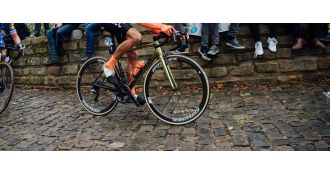

For many, the month of April marks the start of spring, a season of blossom and new beginnings. For us cyclists, however, it only means one thing: cobblestones.
With all the racing that’s been going on recently, you’ve no doubt been inspired to ditch the turbo trainer and go off outdoors in search of some of your own cobblestones to ride, itching to release your inner Flandrian.
Before you make that leap of faith and leave the comfort of the turbo trainer behind, have a read of these tips and tricks to prepare you for the pavé ahead…
Cobble-proof your cockpit
There are a number of different ways to make your ride a little more forgiving over cobblestones, and the pros employ a number of these when they’re riding races like Paris-Roubaix and the Tour of Flanders.
The big one is double-wrapping your handlebars. It’s an age-old tip but one that’s definitely stood the rest of time. With more cushioning for your palms, they’re less likely to become numb after long stretches on cobbles. Two layers of tape also help to absorb some of the bone-shaking chatter from the road below, making for a slightly smoother ride.
Watch out for rubbing
Bouncing around on cobblestones can do a lot of damage to your rear end, but it can also do some lasting damage to your bike itself, rubbing cables and bouncing chains wearing through the protective lacquer on your carbon frame. It’s easy to protect against this rubbing with a little bit of electrical tape, but we’d advise you invest in some proper frame protectors, particularly if you’re planning a long ride on the cobblestones.
Tyre check
Around the time of Paris-Roubaix, you’ll hear a lot of stories coming out of the peloton of pros fixating on what tyre pressures themselves and their rivals are running. That’s because there’s a PSI ‘goldilocks zone’ at usually around the 60-70 mark. Too soft and you’ll struggle to get up to speed; too hard and your arms will disintegrate from all the shaking. Make sure your tyres are ready for the cobbles you plan on tackling by using a floor pump with a built-in PSI gauge.
Tyre tread and width is another thing to consider, the wider and more grippy the better. Cyclocross tyres work well, as do a lot of skinny MTB tyres, just make sure they fit your wheels and within your fork and frame before you buy them.
Grab your own cobble-crusher
Not all of our fancy, expensive and delicate carbon bikes are quite ready to take cobblestones. If you’re a little protective over your prized racing machine, then why not use this opportunity to buy a brand-new bike, one that can crush cobbles with ease.
Our cyclocross and adventure bikes are an obvious choice, with wider tyres, disc brakes and more relaxed geometries which are perfectly suited for riding over rough terrain.
Aluminium sportive bikes are another great choice that many forget about. Like adventure bikes they have a more relaxed position, but like road bikes they’re super quick off the mark and incredibly nippy in their handling – perfect for charging over cobbles or dodgy surfaces.
Final quick tips
Bar tape on your pedals: re-purpose your old pieces of tape and stick them to the baseplate of your pedals for a little bonus vibration dampening and to prevent your cleats from slipping around.
Grip tape on your bottle cage: dig up that old skateboard and put the grip tape to good use.
Churn the biggest gear: not really a tech tip, more a piece of riding advice. The faster you ride over the cobbles, the smoother they seem as your bike quite literally glides from stone to stone.
Ready and rearing to get out there? Why not first head down to the shop and get a pre-ride bike check-up, maybe even ask our mechanics where the best local stretches of cobbles can be found.